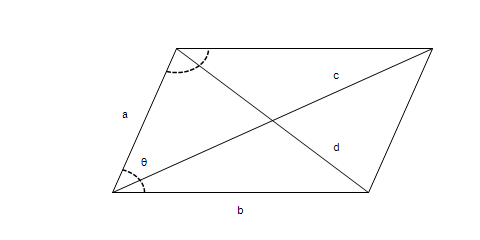In the figure below, a = 6, c = 12, and d = 10. Use this information to solve the parallelogram for b. The diagonals of the parallelogram are represented by c and d. Round your answer to two decimal places.
 figure not drawn to scale
figure not drawn to scale
A. 2.54
B. 5.91
C. ?9.27
D. 6.33?
E. 7.59
Answer: C
You might also like to view...
A ladder leans against a wall so that its slope is 3.61 feet per foot. The top of the ladder is 11 vertical feet above the ground. What is the horizontal distance from the base of the ladder to the wall? (Assume that the positive direction points from the base of the ladder toward the wall.) ?
A. 3.05 feet B. 0.33 feet C. 3.15 feet D. 0.95 feet
Find the general form of the equation for the line with the given properties.Slope =  ; containing (0, 2)
; containing (0, 2)
A. -5x + 6y = 12 B. -5x - 6y = 12 C. 6x - 5y = -12 D. -5x + 6y = -12
Solve the problem.Suppose that  is invested at an interest rate of
is invested at an interest rate of  per year, compounded continuously. What is the balance after 3 years?Round to the nearest cent.
per year, compounded continuously. What is the balance after 3 years?Round to the nearest cent.
A. $6348.00 B. $7044.00 C. $7140.33 D. $7240.33
Simplify the expression. Assume that all variables represent nonnegative real numbers. - 3
- 3 - 2
- 2
A. -5
B. -16
C. -16
D. -5